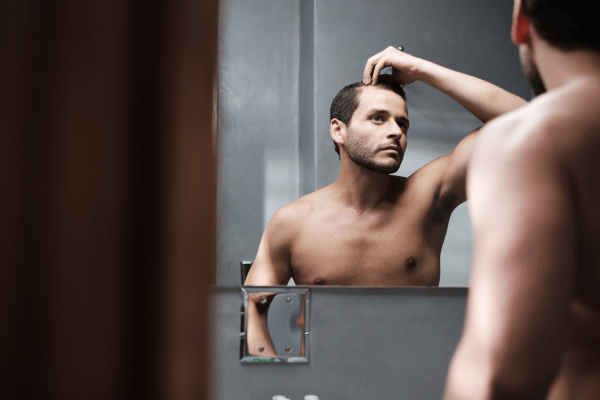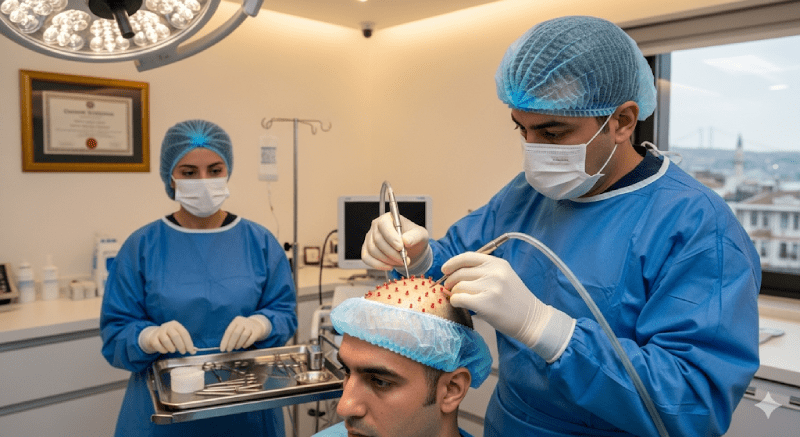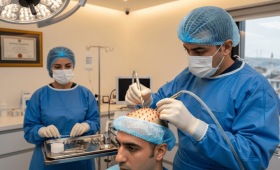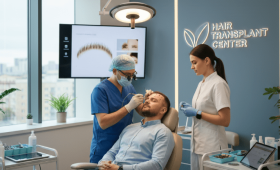Why Is Getting a Hair Transplant Abroad Popular?
Getting a hair transplant abroad has become popular for several reasons, including cost advantage, high surgeon experience, and access to advanced technology. Countries like Turkey can offer the same quality of service at much more affordable prices compared to European and North American countries due to lower living expenses. In addition, with the development of health tourism, surgeons in these countries gain significant international experience by working with a large volume of patients. Package prices and easy travel options are other factors that increase this popularity.
What Are The Most Popular Countries for Hair Transplant?
Among the most popular countries for hair transplantation, Turkey, Mexico, and Hungary stand out. Turkey is a world leader in this field with the widespread use of modern techniques like FUE and DHI and affordable “all-inclusive” packages. Mexico is preferred, especially by North American patients, due to its geographical proximity and lower prices compared to the United States. Hungary is also an important destination in Eastern Europe, offering quality service at more reasonable prices.
Why Do Hair Transplant Costs Vary So Much from Country to Country?
Differences in hair transplant costs depend on a number of economic and operational factors. Living expenses, surgeon and health personnel salaries, clinic rent, and operating costs vary greatly from country to country. For example, these costs are much lower in Turkey than in Western Europe. In addition, government policies supporting health tourism and intense competition in the sector cause prices to drop in some countries, while the cost of maintaining high standards increases prices in others.
How Can I Find the Best Hair Transplant Surgeon?
Finding the best hair transplant surgeon requires a comprehensive research process. The surgeon’s experience, previous patient results (before/after photos), and international certifications (e.g., IAHRS, ISHRS memberships) are important. Also, contacting the clinic to find out who will perform the operation (a surgeon or a technician) and inquiring about the guarantee and follow-up services offered by the clinic play a vital role in making the right decision.
Is It Safe to Go Abroad for a Hair Transplant?
Provided the right research is done and a reliable clinic is chosen, getting a hair transplant abroad is extremely safe. Many clinics specializing in health tourism, as in Turkey, provide services in accordance with international health and hygiene standards. It is a critical step for patients to carefully examine the clinic’s international accreditations, the surgeon’s background, and genuine patient reviews to minimize potential risks.
What Do Treatment Packages Abroad Cover?
Hair transplant treatment packages abroad often include many additional services besides the operation itself. These “all-inclusive” packages may cover airport transfers, a certain number of nights of hotel accommodation, post-operative medications, care products such as shampoo and lotion, and a translation service for English speakers or other languages during the operation. These packages are designed to make the patients’ travel and treatment process easier and less stressful.
What Is the Difference Between FUE and DHI?
FUE (Follicular Unit Extraction) and DHI (Direct Hair Implantation) are the two most commonly used hair transplant methods. In FUE, hair follicles are harvested one by one using a special micromotor or manual punch and then transplanted into channels opened in the scalp. In DHI, hair follicles are harvested with a special tool called the “Choi Implanter Pen” and are directly implanted into the scalp at the same time. While DHI aims to provide a denser and more natural look, the operation time can be longer than FUE and it is generally slightly more expensive.
What Is the Ideal Age Range for a Hair Transplant?
The ideal age for a hair transplant is when hair loss has settled into a pattern and become stable. This is generally 25 years and older. In individuals under 25, the hair loss process may continue, which could lead to new hair loss after the operation and necessitate a second operation. To determine the most suitable timing, it is important to consult a dermatologist or a hair transplant specialist to check if your hair loss pattern is stable.
How Is Pre-operative Consultation Done Abroad?
Pre-operative consultations for hair transplant abroad are usually conducted on online platforms. Patients take photos of their hair and scalp and send them to the clinics. Specialists evaluate these photos to determine the hair loss condition, the adequacy of the donor area, and the appropriate treatment method. This process allows patients to make a detailed plan and ask their questions before they travel.
What Happens in Case of Failure of a Hair Transplant Abroad?
In the event of a failed hair transplant operation, your clinic’s revision policy is of great importance. Many clinics in Turkey can provide a free or discounted revision surgery guarantee in case of a possible failure. However, this varies for each clinic. Therefore, before the operation, you need to inquire in detail about the clinic’s guarantee policy and the conditions it offers for a possible revision surgery.

How Should Travel and Accommodation Be Planned?
Travel planning for a hair transplant abroad is usually made easier by the packages offered by the clinic. Most “all-inclusive” packages cover all details except air tickets (airport transfer, hotel reservation). Patients only need to buy their air tickets and check the validity of their passports. Clinics make the entire process hassle-free by planning all transfers and accommodation according to the patients’ arrival and departure information.
How Long Does the Post-operative Recovery Process Take?
The post-operative recovery process for a hair transplant usually consists of several stages. Swelling and redness are normal for the first few days. The scabs in the transplanted area fall off within the first 10 days, and the appearance returns to normal. Within the first 3 months, a temporary hair loss called “shock shedding” occurs. New hair growth begins after 4-6 months, and the final results usually become fully apparent within 12-18 months.
What Should People Getting a Hair Transplant Abroad Pay Attention To?
People considering a hair transplant abroad should first pay attention to the international recognition and accreditations of the clinic and the surgeon. They should avoid suspiciously low-priced packages, research the clinic’s hygiene standards, and, if possible, read the reviews of patients who have had operations there before. In addition, it is important to learn about the follow-up and communication facilities after the operation in detail.
How Many Grafts Are Needed?
The number of grafts needed varies depending on the degree of hair loss, the density of the donor area, and the desired result. Generally, 1000-2000 grafts are sufficient for mild hair loss cases, while 2000-4000 grafts may be required for moderate hair loss. For advanced hair loss, more than 4000 grafts may be needed. A hair transplant surgeon’s evaluation is essential to determine the exact number of grafts.
How Is the First Wash Done After a Hair Transplant?
The first wash after a hair transplant is usually done by the clinic itself 2-3 days after the operation or by the patient according to the doctor’s instructions. This wash is very important for softening and shedding the scabs in the transplanted area. A special lotion and shampoo are usually used, and the hair must be handled very gently. Performing the first wash correctly directly affects the success of the operation.
What Is Shock Shedding and Why Does It Happen?
Shock shedding is the temporary shedding of transplanted hair within 1-3 months after the hair transplant operation. This condition is a stress reaction that hair follicles experience while trying to adapt to their new location. Shock shedding does not mean the operation has failed; on the contrary, it is a normal sign that the hair follicles are preparing for a new growth cycle. After this process, permanent hair will begin to grow in place of the shed hair.
Are the Transplanted Hairs Permanent for Life?
Yes, hairs transplanted with the correct techniques are permanent for life. This is because the hair follicles used in the transplant are taken from the nape of the neck (the donor area), which is genetically resistant to hair loss. These follicles retain this characteristic in their new location and do not fall out. Therefore, a hair transplant offers a permanent solution.
Does a Scar Remain After a Hair Transplant?
Modern hair transplant methods like FUE and DHI aim to leave a minimal scar. With the FUE method, small, dot-shaped scars may remain in the donor area where the hair follicles were harvested. However, these scars generally become invisible when the hair grows. With the DHI method, these scars are even more minimal and are almost unnoticeable. Therefore, the concern about a permanent scar after a hair transplant is generally unfounded.
What Is the Best Time to Get a Hair Transplant?
There is no specific seasonal restriction for a hair transplant operation. However, weather that is not excessively hot or cold, such as in the spring or autumn months, can be more comfortable for the recovery process. People who have an operation in sunny weather should protect the transplanted area from direct sunlight. Therefore, climate conditions should also be considered when planning the surgery.
What Factors Affect Hair Transplant Prices?
Hair transplant prices vary depending on many factors. These include the number of grafts to be transplanted, the method to be used (FUE, DHI), the reputation of the clinic and the surgeon, the economic conditions of the country where the operation will be performed, and the content of the service package offered (accommodation, transfers, medications, etc.). The price quote for each patient is determined according to personal needs.
How Should Smoking and Alcohol Consumption Be After a Hair Transplant?
Smoking and alcohol consumption should be absolutely avoided for at least 1 week before and after the hair transplant operation. Smoking slows down blood flow, which prevents the hair follicles from getting nourished and delays wound healing. Alcohol thins the blood, which increases the risk of bleeding. The consumption of these substances negatively affects the success of the operation and the recovery process.
When Is Sexual Intercourse Possible After a Hair Transplant?
It is recommended to avoid sexual intercourse for the first few days after a hair transplant operation due to swelling and sensitivity in the head area. Intense physical activity and sweating can damage the newly transplanted hair follicles and increase the risk of infection. Generally, it is advised to stay away from sexual activity for 1 week after the operation for a healthy recovery process.
When Can Sports Be Done After a Hair Transplant?
Heavy physical activities and sports that cause sweating should be avoided for the first 2 weeks after a hair transplant. Light walks can be done after a few days, but it is recommended to wait at least 1-2 months for more intense activities like swimming, running, or contact sports. Sweating can increase the risk of infection in the transplanted area.
When Can Air Travel Be Done After a Hair Transplant?
Air travel can generally be done safely 24-48 hours after a hair transplant operation. Most clinics provide preventive advice to patients against pressure changes that can be caused by air travel. However, it is important to consult your doctor and take necessary precautions, especially for long flights.
Are Clinics That Offer Price Guarantees Reliable?
A price guarantee is a service where some clinics commit to keeping the package price fixed without adding extra costs. This is beneficial for patients in terms of budget planning. However, when choosing clinics that offer a price guarantee, one should not focus only on the price, but also carefully examine the quality of the clinic, the surgeon’s experience, and patient reviews.
Are Headaches and Swelling Normal After a Hair Transplant?
It is normal to feel a slight headache and swelling in the head area after a hair transplant operation, especially for the first few days. This condition occurs due to the nature of the operation and can be easily managed with prescribed painkillers. The swelling can usually start from the forehead and go down to the eye area, but it will subside on its own within a few days.

What Is the Best Age for Hair Transplant Abroad?
The best age is when hair loss has become permanent. In individuals aged 25 and over, the hair loss pattern has settled, which ensures more permanent and successful results after the transplant. If a hair transplant is performed at a younger age, hair loss may continue, and a new operation may be needed in the future.
What Documents Are Required for a Hair Transplant Abroad?
Generally, your passport and air ticket are sufficient for a hair transplant abroad. A visa may be required for some countries, but Turkey does not require a visa from many countries. Clinics can assist patients with their travel and accommodation documents.
What Should Be Paid Attention to Before a Hair Transplant?
One of the most important things to pay attention to before a hair transplant is to stop smoking, consuming alcohol, and taking blood thinners (like aspirin) at least 1 week before the operation. In addition, it is recommended to wear comfortable clothes on the day of the operation and have a light breakfast a few hours before the operation.
How to Choose a Hair Transplant Clinic Abroad?
When choosing a hair transplant clinic abroad, first check the clinic’s website and social media accounts. Look at the before and after photos of operations the clinic has performed before and read international patient reviews. Also, do not forget to inquire about the guarantee and follow-up services offered by the clinic.
When Can Hair Be Cut After a Hair Transplant?
After a hair transplant operation, the transplanted hair needs a certain amount of time to fully heal and settle. It is recommended not to cut the hair for the first 1 month after the operation. It is important to wait 3 months for a scissor cut and 6 months for a machine shave to avoid damaging the hair follicles.
Is the DHI Method Suitable for Everyone?
The DHI method is particularly suitable for people with less hair loss or those who want to get a transplant without shaving their hair. This method helps to achieve a natural look because it allows for a more precise determination of the direction and angle of the hairs. However, if a very large area needs to be transplanted, the FUE method may be more practical and effective.
When Is a Revision Surgery Needed?
Revision surgery may be needed in cases where the first operation is unsuccessful, the desired density in the transplanted area is not achieved, or the direction of the transplanted hair is unnatural. This operation is usually planned at least 1 year after the first operation, once the final results have fully emerged.
What Are the Best Care Products After a Hair Transplant?
The best care products after a hair transplant are usually recommended by your doctor. These products include special pH-balanced shampoos, lotions, and vitamin supplements that support hair growth. Regular use of these products helps the hair follicles grow faster and healthier.
In Which Country Is Accommodation More Affordable for a Hair Transplant?
Turkey, as part of its health tourism packages, often offers free or very low-cost accommodation options. The possibility of staying in 5-star hotels increases the comfort of patients while keeping the cost to a minimum. In countries like Mexico and Spain, accommodation costs are generally borne by the patient, and this can increase the total cost.



